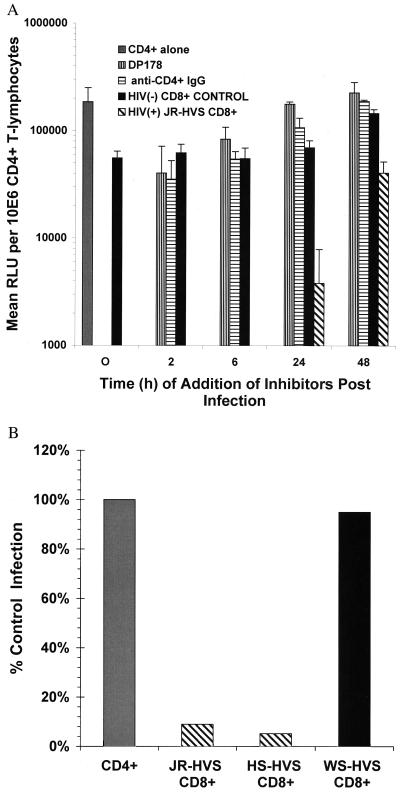Figure 3.
(A) Kinetics of CD8+ T cell-mediated suppression and X4 HIV-1 entry in primary CD4+ T lymphocytes. CD4+-enriched T lymphocytes were infected with X4 HIV pseudotyped virus (NL4–3). Two agents that inhibit viral entry were added at different times after infection. DP178 is an HR2 peptide mimetic that blocks gp41-mediated fusion. Anti-CD4+ mAb #19 blocks binding of gp120 to CD4+. Transformed CD8+ T cells from an asymptomatic HIV+ individual (hatched bars) or CD8+ T cells from a pool of HIV− donors (solid bars) were added at a 2:1 E:T at various times after infection. At 24 h, the CD8+ effectors had a 94.3% inhibition of control infection that was limited to 77% at 48 h. The results shown are the average of two or three experiments performed in duplicate. RLU, relative light units. (B) CD8+ suppression is independent of HIV-1 envelope-mediated entry. CD4+-enriched T lymphocytes were infected with a reporter virus pseudotyped with the A-MLV envelope for 2 h, and then the virus was removed. HVS-transformed CD8+ T cells with X4 suppressive activity (JR-HVS and HS-HVS, hatched bars) or HVS-transformed CD8+ T cells without X4 suppressive activity (WS-HVS, solid bars), were added at a 2:1 E:T after removal of the virus. Percentage of infection is calculated based on infection of the CD4+ targets without CD8+ T cells (100%). Results are an average of three experiments for JR-HVS (5.2%) and HS-HVS CD8+ effectors (9%) and two experiments for the WS-HVS CD8+ cells (95%).

